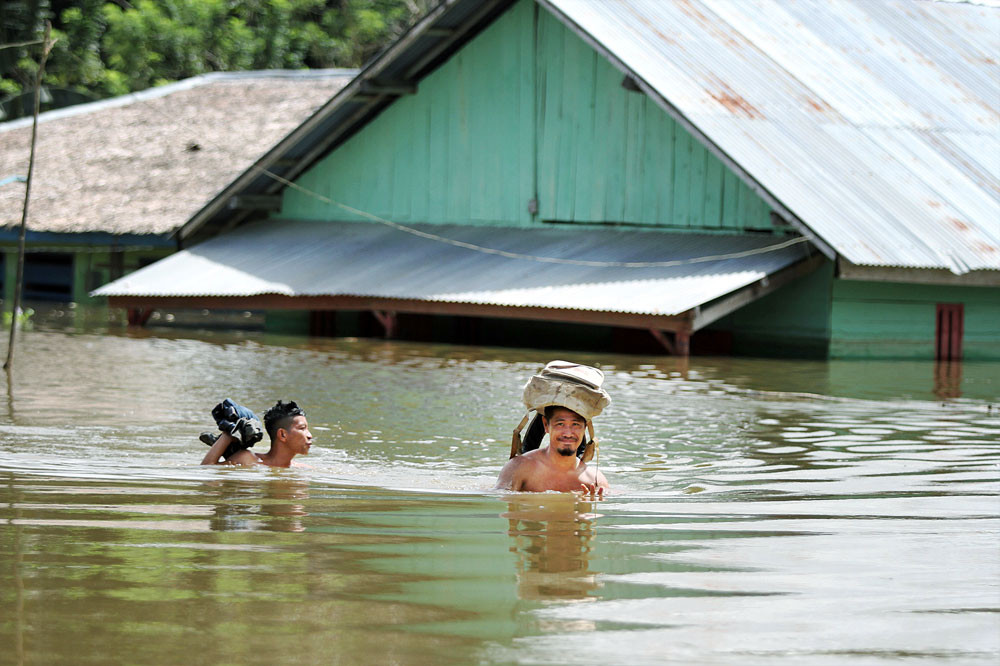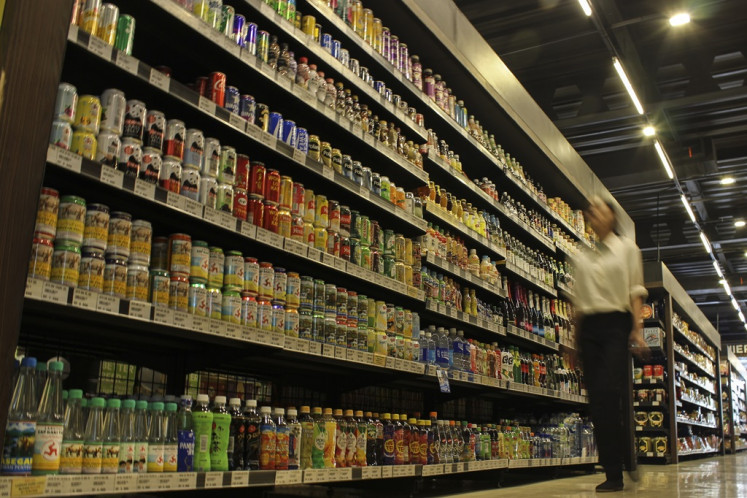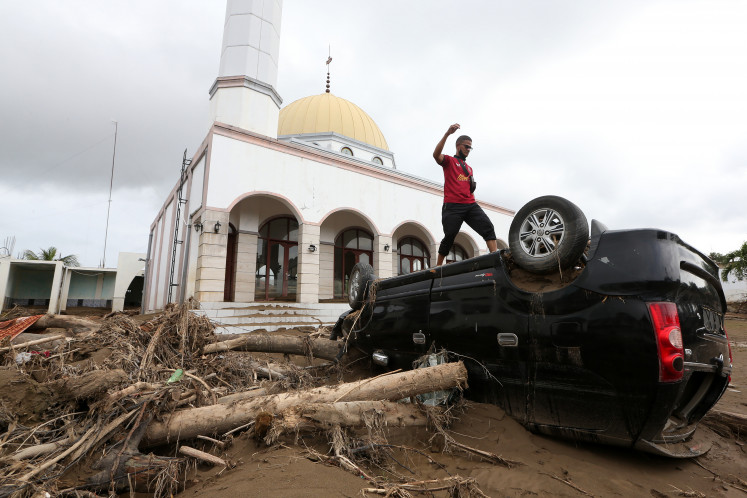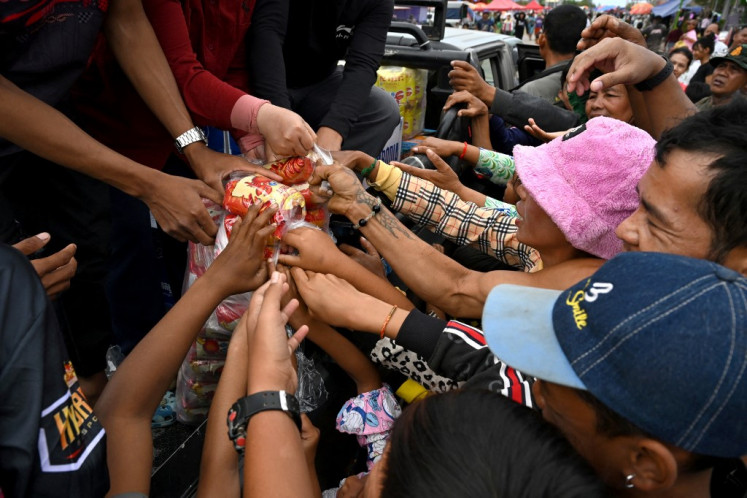Popular Reads
Top Results
Can't find what you're looking for?
View all search resultsPopular Reads
Top Results
Can't find what you're looking for?
View all search resultsFocus on women and girls matters as disaster risks shift
Both gender equality and disaster risk reduction are collective responsibilities requiring whole-of-society engagement.
Change text size
Gift Premium Articles
to Anyone
 Two people wade through floodwaters in Tonduno village, South Konawe regency, Southeast Sulawesi, on Monday. Twenty-eight villages in 17 districts in the regency are reportedly inundated with floodwater that has damaged thousands of homes and displaced 995 people, according to the local natural disaster mitigation agency. (Antara/Jojon)
Two people wade through floodwaters in Tonduno village, South Konawe regency, Southeast Sulawesi, on Monday. Twenty-eight villages in 17 districts in the regency are reportedly inundated with floodwater that has damaged thousands of homes and displaced 995 people, according to the local natural disaster mitigation agency. (Antara/Jojon)
A
t its heart, ASEAN Agreement on Disaster Management and Emergency Response has a simple but visionary objective to reduce disaster risks and losses in lives. Its legally binding and comprehensive scope has brought all 10 ASEAN member states to work together.
As the region is among the most disaster-prone in the world, such regional cooperation is indispensable for the achievement of the 2030 Agenda for Sustainable Development as well as the ASEAN Vision on Disaster Management 2025, which are fully aligned with the Sendai Framework for Disaster Risk Reduction. In this connection, integrating the gender perspective into disaster management policies and practices is fundamental to ASEAN’s strategy for achieving both ASEAN’s vision and its aspiration to demonstrate global leadership.
In 2021, the International Day for Disaster Risk Reduction focuses on international cooperation to support developing countries in implementing the Sendai Framework. Nowhere is this cooperation more important than for the rights and empowerment of the region’s women and girls.
This is not just a goal but also a key part of any effective disaster risk reduction strategy. This principle is central to the mechanisms adopted by ASEAN, with the support of the UN, to put into place the commitments of the Sendai Framework and other development objectives.
Southeast Asian countries are no stranger to floods, earthquakes and droughts. They have made clear progress in the traditional disaster management of these events in recent years. The average annual number of lives lost to natural hazards in Asia and the Pacific has fallen from 10,936 in the decade 2011-2020 to 6,200 in 2019-2020. But the arrival of the COVID-19 pandemic, together with the increasing frequency and intensity of weather events due to climate change, have brought upheaval to this landscape of risk.
ASEAN regional cooperation has translated into meaningful action to consolidate the vision of One ASEAN One Response in disasters. The region is well placed to elevate its efforts to be even more inclusive and gender-responsive to mitigate risks and ensure that the hard-won development gains over the past two decades are not lost.
This is very much in line with ASEAN’s priorities to advance the Women Peace and Security agenda to address emerging non-traditional security threats facing the region. We must build on increasing focus on addressing women’s safety and security challenges and gender-based vulnerabilities during and after natural hazards to ensure that women’s valuable contributions to preventing and mitigating disasters and emergency response are recognized and meaningfully supported.
Over the recent years, ASEAN has increasingly focused on gender equality as an integral part of sustainable development. Evidently, the ASEAN Agreement on Disaster Management and Emergency Response (AADMER) Work Program 2021-2025 for the first time has incorporated gender and social inclusion.
The pandemic has presented us with further opportunities to build back better and also support the Sendai Framework. We have therefore collectively seized this opportunity to institutionalize several measures to address gender equality and the empowerment of women in this new normal:
First, enhanced policy coherence at the regional level. Gender equality and disaster risk reduction are both cross-cutting requirements for sustainable development. ASEAN is, therefore, and for the first time, engaging each of them more explicitly in the program of the other. Over the next five years, the ASEAN Committee on Disaster Management will implement the AADMER Work Program 2021-2025 that fully mainstreams gender and social inclusion, while the ASEAN Committee on Women will implement a work plan that mainstreams resilience to disasters and climate change. In enacting these complementary visions, we underscore that both gender equality and disaster risk reduction are collective responsibilities requiring whole-of-society engagement.
Second, established a cross-sectoral mechanism to support and monitor implementation against gender commitments. ASEAN has established a new Technical Working Group on Protection, Gender, and Inclusion. This group convenes bodies for the respective sectors of disaster management, gender, and social welfare and development. This has allowed us to monitor progress and collectively work toward gender equality and ending gender-based violence in disaster management and other areas. We have tapped into the technical resources of key partners, including the UN, Red Cross Red Crescent Movement, and civil society, to help us realize this vision.
Third, developed a new regional framework on protection, gender, and inclusion in disaster management. Launched today during the ASEAN Ministerial Meeting on Disaster Management, the Framework articulates a common vision for promoting protection, gender, and inclusion in disasters in the ASEAN region. This will be the key tool for ensuring coordinated, coherent, cross-sectoral action to advance gender equality and social inclusion in disaster management at the regional level, and providing guidance to do the same at the national level.
What comes next is the translation of these lessons and frameworks into action for those most impacted by disasters in the region. We are lucky not to be alone on this journey. Decades of facing disaster risk have given us decades of experience, and virtual operating modalities have enabled us to learn from one another.
In the age of transboundary risk, this has been critical. Each country in the region has offered lessons learned, from promoting women’s engagement in early warning systems in Vietnam, to developing applicable tools and guidelines on gender in Thailand, to strengthening policy environments in the Philippines. Collectively, we inch closer to our goals.
In a landscape of compounded risks, we must predict what we can, and act accordingly. UN Secretary-General António Guterres has called for urgent scaling up of funds for climate change adaptation and resilience-building programs, to provide real and lasting protection against the impact of major events.
The evidence over the past decades is indisputable: Disasters will increase the risk of gender-based violence, increase the burdens of unpaid care for women, and roll back gains in women’s economic empowerment. Any investments made in resilience-building in the region must put their rights front and center, with flexible funding earmarked for women’s organizations serving them on the ground. Only then can we mitigate the loss of lives and livelihoods that otherwise awaits.
The challenging future is already here, and we cannot afford to fail.
***
Riyanti Djalante is head of Disaster Management and Humanitarian Assistance Division at ASEAN Secretariat. Mohammad Naciri is regional director of UN Women Asia and the Pacific.









